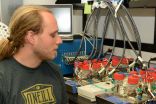In a new study, the Stanford team demonstrates for the first time how methanogens obtain electrons from solid surfaces. The discovery could help scientists design electrodes for microbial "factories" that produce methane gas and other compounds sustainably.
"There are several hypotheses to explain how electrons get from an electrode into a methanogen cell," said Stanford postdoctoral scholar Jörg Deutzmann, lead author of the study. "We are the first group to identify the actual mechanism."
The study is published in the current issue of the journal mBio.
"The overall goal is to create large bioreactors where microbes convert atmospheric carbon dioxide and clean electricity from solar, wind or nuclear power into renewable fuels and other valuable chemicals," said study co-author Alfred Spormann, a professor of chemical engineering and of civil and environmental engineering at Stanford. "Now that we understand how methanogens take up electricity, we can re-engineer conventional electrodes to deliver more electrons to more microbes at a faster rate."
The study also provided new insights on microbially influenced corrosion, a biological process that threatens the long-term stability of structures made of iron and steel.
"Biocorrosion is a significant global problem," Spormann said. "The yearly economic loss caused by this process is estimated to be in the $1 billion range."
Methane from microbes
Methane is an important fuel for heating, transportation, cooking and generating electricity. Most methane comes from natural gas, an abundant fossil fuel extracted from wells. However, burning natural gas emits carbon dioxide, which accelerates global warming.
Methanogens offer a promising alternative. These single-celled organisms resemble bacteria but belong to a genetically distinct domain called Archaea.
Commonly found in sediments and sewage treatment plants, methanogens thrive on carbon dioxide gas and electrons. The byproduct of this primordial meal is pure methane gas, which the microbes excrete into the air.
Researchers are trying to develop large bioreactors where billions of methanogens crank out methane around the clock. These microbial colonies would be fed carbon dioxide from the atmosphere and clean electricity from electrodes.
The entire process would be carbon neutral, Spormann explained. "When microbial methane is burnt as fuel, carbon dioxide gets recycled back into the atmosphere where it originated," he said. "Natural gas combustion, on the other hand, frees carbon that has been trapped underground for millions of years."
Electron uptake
Producing microbial methane on an industrial scale will require major improvements in efficiency, Deutzmann said.
"Right now the main bottleneck in this process is figuring out how to get more electrons from the electrode into the microbial cell," he said. "To do that, you first have to know how electron uptake works in methanogens. Then you can engineer and enhance the electron-transfer rate and increase methane production."
In nature, methanogens acquire electrons from hydrogen and other molecules that form during the breakdown of organic material or bacterial fermentation.
"These small molecules are food for the microbes," Deutzmann said. "They provide methanogens with electrons to metabolize carbon dioxide and produce methane."
In the Spormann lab, methanogens don't have to worry about food. Electrons are continuously supplied by a low-voltage current via an electrode. How those electrons get into the methanogen cell has been the subject of scientific debate.
"The leading hypothesis is that many microbes, including methanogens, take up electrons directly from the electrode," Deutzmann said. "But in a previous study, we found evidence that microbial enzymes and other molecules could also play a role. From an engineering perspective, it makes a difference if you have to design an electrode to accommodate large microbial cells versus enzymes. You can attach a lot more enzymes to the electrode, because enzymes are a lot smaller."
Experiments with enzymes
For the experiment, the Stanford team used a species of methanogen called Methanococcus maripaludis. Cultures of M. maripaludis were grown in flasks equipped with a graphite electrode, which provided a steady supply of electrons. The microbes were also fed carbon dioxide gas.
As expected, methane gas formed inside the flasks, a clear indication that the methanogens were taking up electrons and metabolizing carbon dioxide. But researchers also detected a build-up of hydrogen gas. Were these molecules of hydrogen shuttling electrons to the methanogens, as occurs in nature?
To find out, the Stanford team repeated the experiment using a genetically engineered strain of M. maripaludis. These mutant methanogens had six genes deleted from their DNA so they could no longer produce the enzyme hydrogenase, which microbes need to make hydrogen. Although the mutants were grown in the same conditions as normal methanogens, their methane output was significantly lower.
"When hydrogenase was absent from the culture, methane production plummeted 10-fold," Spormann said. "This was a strong indication that hydrogen-producing enzymes are significantly involved in electron uptake."
Further tests without methanogen cells confirmed that hydrogenase and other enzymes take up electrons directly from the electrode surface. The microbial cell itself is not involved in the transfer, as was widely assumed.
"It turns out that all kinds of enzymes are just floating around in the culture medium," Deutzmann said. "These enzymes can attach to the electrode surface and produce small molecules, like hydrogen, which then feed the electrons to the microbes."
Normal methanogen cells produce a variety of enzymes. Stirring, starvation and other biological factors can cause the cells to break open, releasing enzymes into the culture medium, Deutzmann said.
Biocorrosion
"Now that we know that certain enzymes take up electrons, we can engineer them to work better and search for other enzymes that do it even faster," he added. "Another benefit is that we no longer have to design large, porous electrodes to accommodate the entire methanogen cell."
The Stanford team also discovered that methanogen enzymes play a similar role in biocorrosion. The researchers found that granules of iron transfer electrons directly to hydrogenase. The enzyme uses these electrons to make hydrogen molecules, which, in turn, are consumed by methanogens. Eliminating hydrogenase from the environment could slow down the rate of corrosion, according to the scientists.
"At first we were surprised by these results, because enzymes were thought to degrade very quickly once they were outside the cell," Spormann said. "But our study showed that free enzymes attached to an electrode surface can remain active for a month or two. Understanding why they are stable for so long could lead to new insights on reducing corrosion and on scaling up the production of microbial methane and other sustainable chemicals."
INFORMATION:
The mBio paper was also co-authored by Stanford researcher Merve Sahin. The study was supported by the Global Climate and Energy Project at Stanford: http://gcep.stanford.edu
For more information visit the Spormann Lab at http://web.stanford.edu/group/spormannlab/cgi-bin/amslab/




